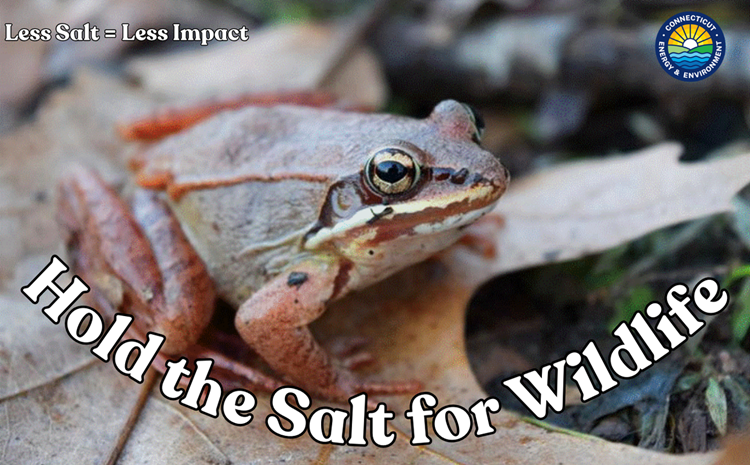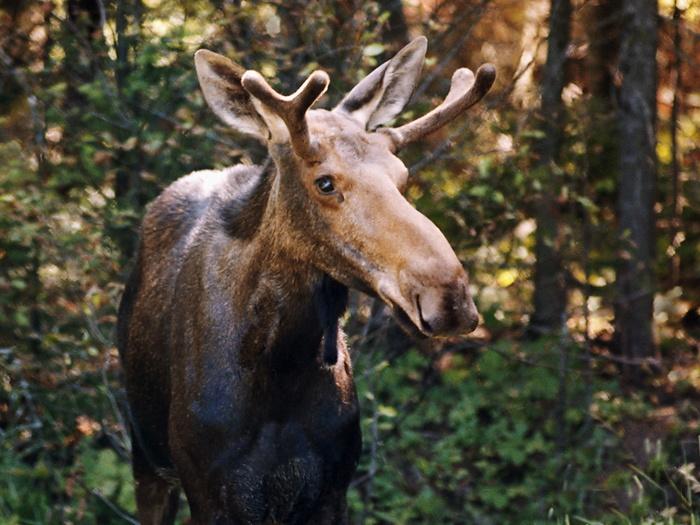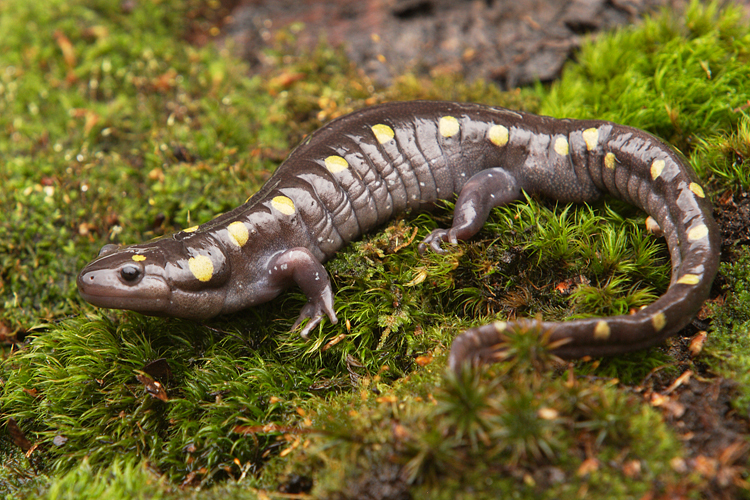Salt Impacts & Our Environment
Salts can negatively impact wildlife and their habitats in a variety of direct and indirect ways. Entire ecosystems (natural communities) and the benefits they provide to people (green spaces, clean air, clean water, etc.) can be altered, and biodiversity (the variety of living things) can be lost.

SALT IMPACTS ON WILDLIFE | SALT IMPACTS ALTER HABITATS | SALT ALTERNATIVES DON’T PROTECT WILDLIFE | RESOURCES
SALT IMPACTS ON WILDLIFE
Environmental impacts from salts can make it impossible for a species to persist (continue to live and thrive) in an affected habitat or alter the species composition (the number and abundance of living things) of an ecosystem. Mammals and birds need salt in their diets so they may be drawn to roads to consume salt. This increases the risk of being struck by a vehicle. Salts that are scattered or washed off hard surfaces by water or wind impact nearby habitats and harm wildlife. Sensitive organisms like amphibians are particularly vulnerable.

Increased Chances of Car Crashes with Wildlife
Winter road salt applications can attract wild animals to the roadways causing unnecessary car collisions that put people and wildlife in danger. During winter when natural salt licks aren’t available, deer and moose are drawn to roadways to replenish their electrolytes, similar to humans drinking sports drinks to balance electrolytes. The animals can become so distracted when eating the road salt or drinking from salty pools that they can be struck by an oncoming vehicle.(1,2)

Like large mammals, birds also need salt as part of their regular diet. If a bird consumes too much road salt, it can poison them. Symptoms of salt poisoning are lethargy, depression, tremors (trembling), torticollis (stiff neck), retropulsion (falling backwards), and partial paralysis . A poisoned bird or a bird that is distracted when feeding on the salt in a roadway increases its chances of being struck by a vehicle.(3)
Salt Impacts to Freshwater Organisms
Salts dissolve and increase the salinity (the amount of dissolved salt in water) of freshwater aquatic environments near roadways, impacting the aquatic organisms that live there. These freshwater organisms include: amphibians, freshwater shellfish, insects, fish, microscopic plants and microscopic animals.

Increased salinity of freshwater aquatic environments like rivers, lakes, or wetlands, may result in the following negative impacts to phytoplankton (microscopic aquatic plants), zooplankton (microscopic aquatic animals), macroinvertebrates (insects, shellfish), amphibians, and fish(4):
- Compromised function of gills of amphibian larva(5) .
- Bloating (oedema) in wood frogs that decreases their mobility(6).
- Reduced survival of spotted salamander larva and wood frog tadpoles(7).
- More salt-tolerant species, such as the invasive Asian clam (Corbicula fluminea), may outcompete (displace them in the competition for food or other resources) native species in salt-impacted habitats(8) .
- Newly hatched rainbow trout grow slower when exposed to road salts(9) .
SALT IMPACTS ALTER HABITATS
When we talk about native species of plants, animals, and other organisms, we are talking about organisms that originated in a particular habitat or ecosystem. Native species exist together in balance. The opposite of a native species is an invasive species. Invasive species have been introduced by humans into an ecosystem or habitat that they are not native to and disrupt the natural balance.
Wildlife also experiences secondary impacts when salt pollution alters the composition of their habitats. Increased salt reduces the native plants in the wetlands which may allow for growth of invasive such as the giant-reed. (Phragmites australis).(10) Areas overtaken by phragmites support fewer native insects, birds, reptiles, and amphibians than habitats comprised of native vegetation such as cattails, rushes, and sedges.
SALT ALTERNATIVES DON’T PROTECT WILDLIFE
We now know the harm salts can cause freshwater aquatic organisms and freshwater ecosystems. So, what are the alternatives to using salts? Many winter maintenance professionals have started using alternative de-icers (materials used for melting snow/ice) such as acetates, formates, glycol, beet juice, molasses, cheese brine, beer yeast, and other carbohydrate-based products.
Alternative deicers such as acetates, formats, glycol have been found to work very effectively for winter maintenance activities, but they have also been linked to changing dissolved oxygen levels in soil and water exposed to these materials.(11)
Other “eco-friendly” alternatives, such as beet juice, molasses, cheese brine, and beer yeast have been advertised as salt-free alternatives, but these carbohydrate-based materials still contain some amount of salt because, on their own, these materials are not effective at melting ice and snow at low temperatures. Rather these materials are used for improving how well the salt sticks to the road. Recent research into the new “eco-friendly” products available on the market suggest they may be more toxic to aquatic macroinvertebrates than traditional salt.(12, 13, 14)
Although many studies have investigated the impact of road salts on wildlife it continues to be an ongoing area of research. There is more to learn about the impacts to the numerous species and various ecosystems that are impacted by salts. However, we do know that when ecosystems are degraded and biodiversity is lost due to salt impacts, the benefits we receive from those ecosystems can be lost. Therefore, if we reduce our salt use as a society, less salt will enter our environment and the known negative impacts to soils and plants will be reduced.
RESOURCES
1. Fraser, D. 1979. Sightings of moose, deer, and bears on roads in northern Ontario. Wildlife Society Bulletin 7:181-184. http://www.jstor.org/stable/3781763
2. LeBlond, M. C. Dussault, J.P. Ouellet, M. Poulin, R. Courtois, J. Fortin. 2010. Management of roadside salt pools to reduce moose-vehicle collisions. Journal of Wildlife Management 71:2304-3210. https://doi.org/10.1111/fwb.13907
3. Mineau, P., L.J. Brownlee. 2005. Road salts and birds: an assessment of the risk with particular emphasis on winter finch mortality. Wildlife Society Bulletin 33:835-841. https://doi.org/10.2193/0091-7648(2005)33[835:RSABAA]2.0.CO;2
4. Hintz, W.D., and R.A. Relyea. 2019. A review of the species, community, and ecosystem impacts of road salt salinisation in fresh waters. Freshwater Biology 64:1081-1097. https://doi.org/10.1111/fwb.13286
5. Szeliogowski, R.V., J.A. Scanley, C.C. Broadbridge, S.P. Brady. 2022. Road salt compromises functional morphology of larval gills in populations of an amphibian. Environmental Pollution 292:118441. https://doi.org/10.1016/j.envpol.2021.118441
6. Brady, S.P., D. Goedert, LE. Frymus, F.J. Zamora-Camacho, P.S. Smith, C.J. Zeiss, M. Comas, T.A. Abbott, S.P. Basu, J.C. DeAndressi, M.E. Forgione, M/J/ Maloney, J.L. Priester, F. Senturk, R.V. Szeligowski, A.S. Tucker, M. Zhang, R. Calsbeek. 2022. Salted roads lead to oedema and reduced locomotor function in amphibian populations. Freshwater Biology 67:1150-1161.https://doi.org/10.1111/fwb.13907
7. Karraker, N.E., J.P. Gibbs, J.R. Voneshi. 2008. Impacts of road deicing salt on the demography of vernal pool-breeding amphibians. Ecological Applications 18:724-734. https://doi.org/10.1890/07-1644.1
8. Coldsnow, K.D., R.A. Relyea. 2018. Toxicity of various road-deicing salts to Asian clams (Corbicula fluminea). Environmental Toxicology and Chemistry 37:1839-1845. https://doi.org/10.1002/etc.4126
9. Hintz, W.D., R.A. Relyea. 2017. A salty landscape for fear: responses of fish and zooplankton to freshwater salinization and predatory stress. Oecologia 185:147-156. https://doi.org/10.1007/s00442-017-3925-1
10. Richburg J.A., W.A. Patterson III, F. Lowstein. 2001. Effects of road salt and Phragmites australis invasion on the vegetation of a Western Massachusetts calcareous lake-basin fen. Wetlands 21:247-255. https://doi.org/10.1672/0277-5212(2001)021[0247:EORSAP]2.0.CO;2
11. Mahoney, J., Jackson, E., Larsen, D., Vadas, T., Wille, K., Zinke, S. 2015. Winter Highway Maintenance Operations: Connecticut.
12. Gillis, P.L., Salerno, J., Bennett, C.J., Kudla, Y., Smith, M. 2021. The relative toxicity of road salt alternatives to freshwater mussels; examining the potential risk of eco-friendly de-icing products to sensitive aquatic species. ACS EST Water 1:1628-1636. https://doi.org/10.1021/acsestwater.1c00096
13. Picinic, B., Durant, A., Donini, A. 2022. Effect of salt and brine-beet juice de-icer on osmoregulatory physiology of the freshwater amphipod Hyalella Azteca (Saussure, 1858)(Amphipoda: Hyalellidae). J. of Crustacean Biology 42:1-11. https://doi.org/10.1093/jcbiol/ruac025
14. Nutile, S.A., Solan, M.E. 2019. Toxicity testing of “eco-friendly” de-icing formulations using Chironomus dilutus. Environmental Pollution 246:408-413. https://doi.org/10.1016/j.envpol.2018.12.033
15. Find additional research on the impact of road salts on amphibians here: https://northeastparc.org/docs/NEPARC-RoadSaltBibliography.pdf

FAQs | StoryMap: More Than Just a Grain | What Can I Do? | Resources

